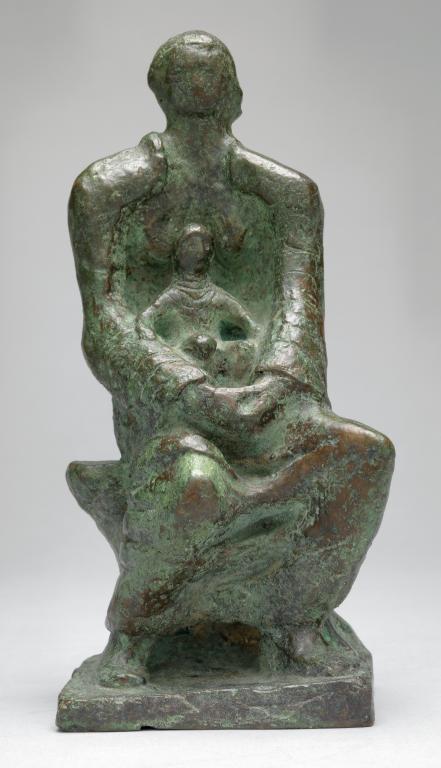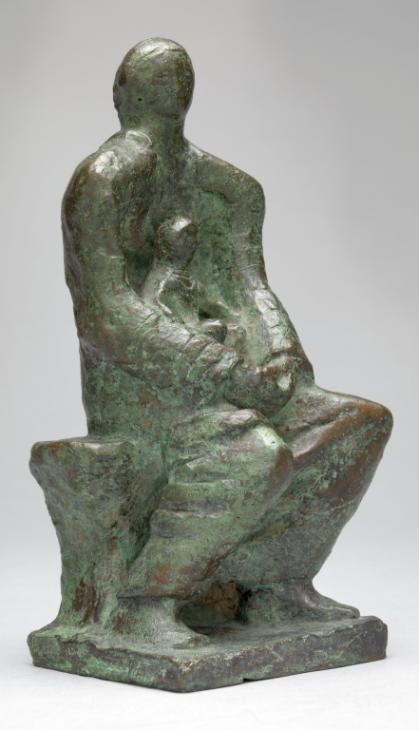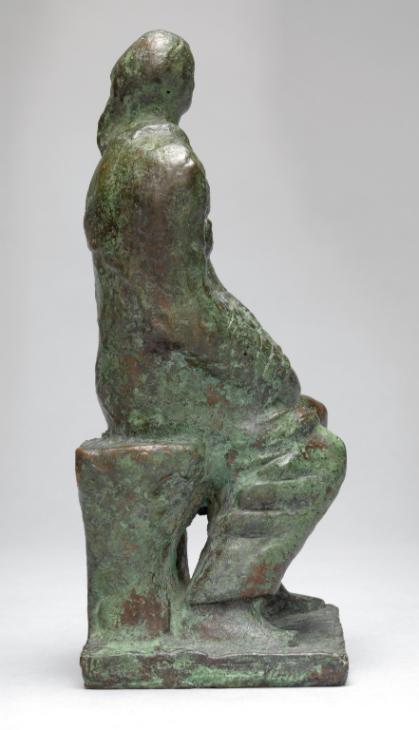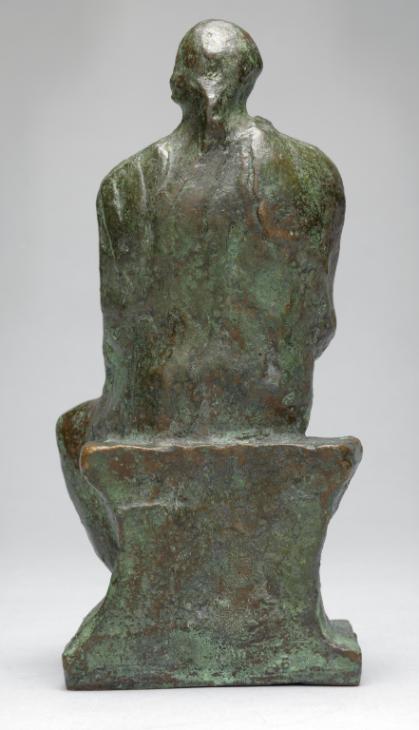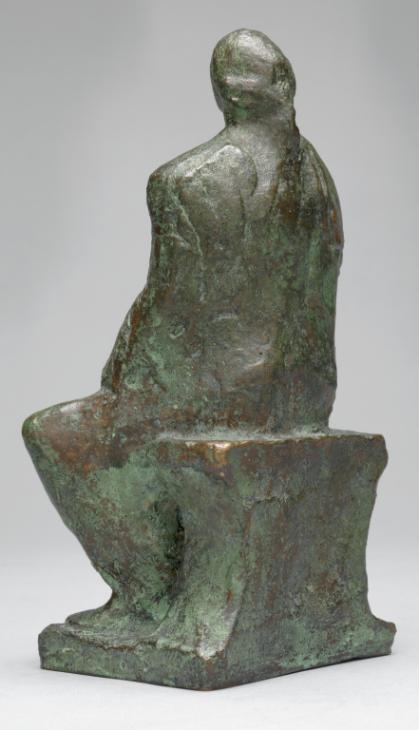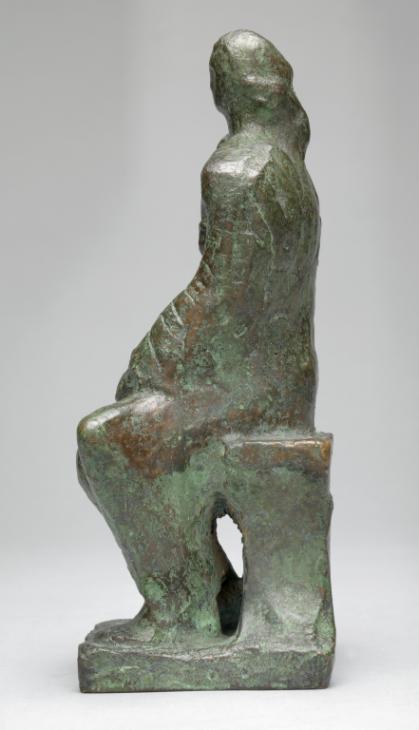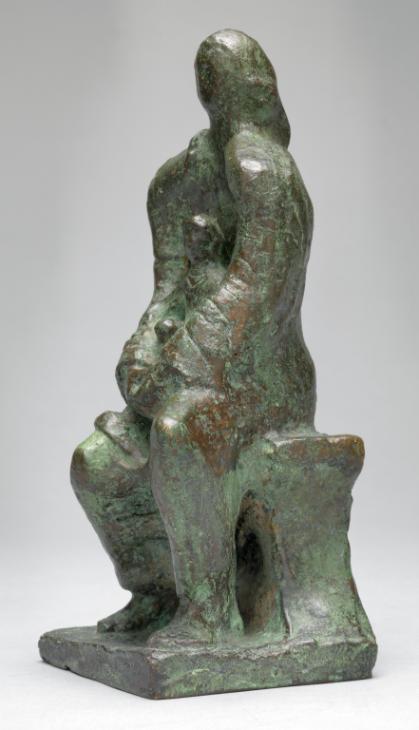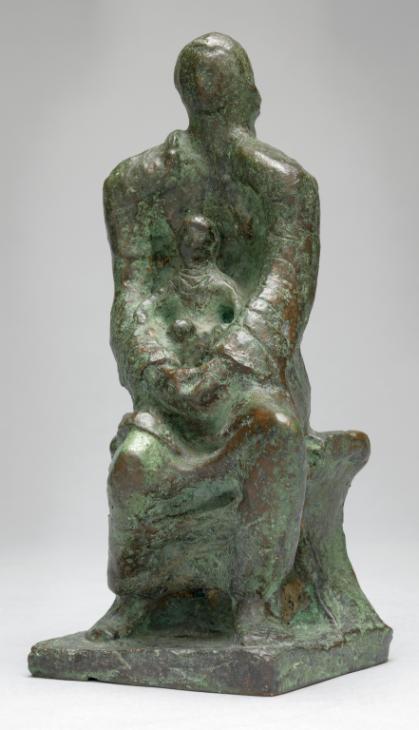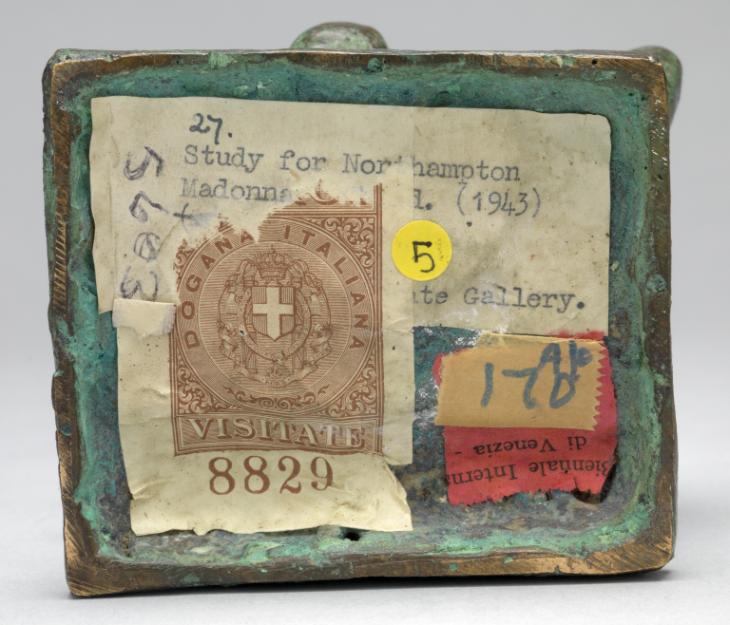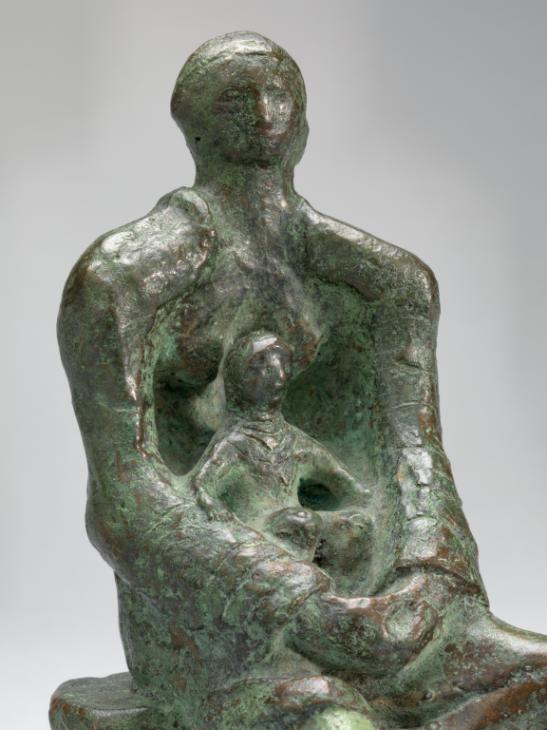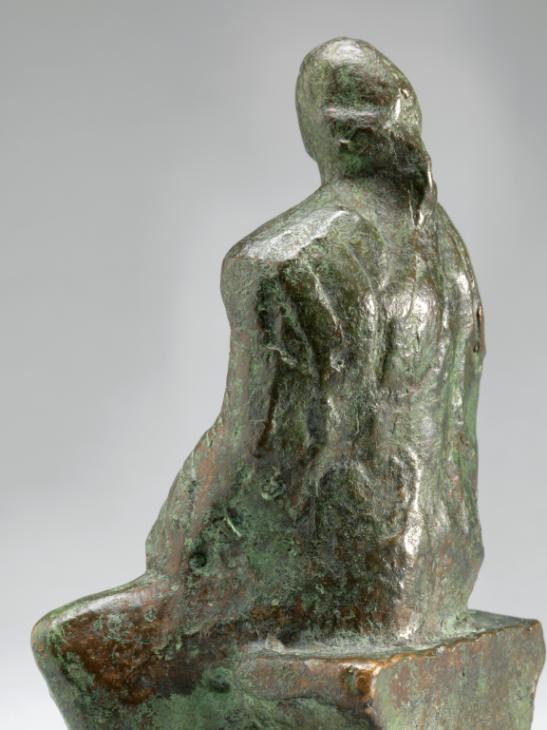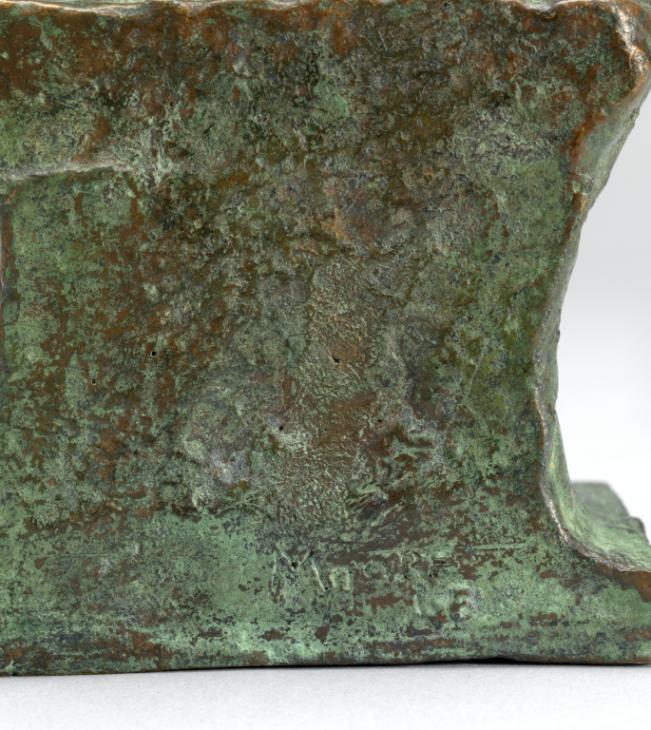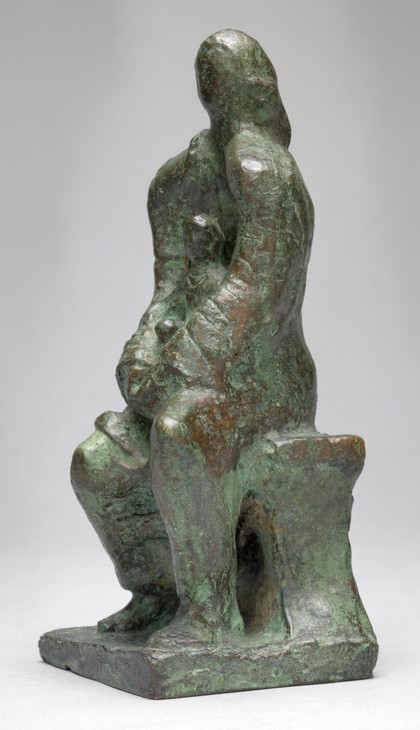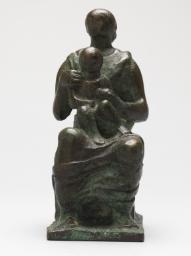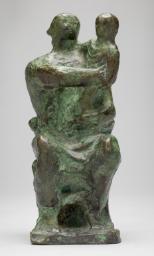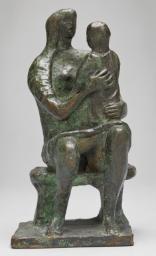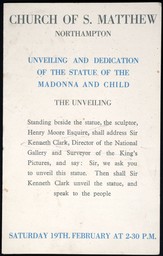Henry Moore OM, CH Maquette for Madonna and Child 1943, cast 1944-5
Image 1 of 13
-
 Henry Moore OM, CH, Maquette for Madonna and Child 1943, cast 1944-5© The Henry Moore Foundation. All Rights Reserved© The Henry Moore Foundation. All Rights Reserved
Henry Moore OM, CH, Maquette for Madonna and Child 1943, cast 1944-5© The Henry Moore Foundation. All Rights Reserved© The Henry Moore Foundation. All Rights Reserved -
 Henry Moore OM, CH, Maquette for Madonna and Child 1943, cast 1944-5© The Henry Moore Foundation. All Rights Reserved© The Henry Moore Foundation. All Rights Reserved
Henry Moore OM, CH, Maquette for Madonna and Child 1943, cast 1944-5© The Henry Moore Foundation. All Rights Reserved© The Henry Moore Foundation. All Rights Reserved -
 Henry Moore OM, CH, Maquette for Madonna and Child 1943, cast 1944-5© The Henry Moore Foundation. All Rights Reserved© The Henry Moore Foundation. All Rights Reserved
Henry Moore OM, CH, Maquette for Madonna and Child 1943, cast 1944-5© The Henry Moore Foundation. All Rights Reserved© The Henry Moore Foundation. All Rights Reserved -
 Henry Moore OM, CH, Maquette for Madonna and Child 1943, cast 1944-5© The Henry Moore Foundation. All Rights Reserved© The Henry Moore Foundation. All Rights Reserved
Henry Moore OM, CH, Maquette for Madonna and Child 1943, cast 1944-5© The Henry Moore Foundation. All Rights Reserved© The Henry Moore Foundation. All Rights Reserved -
 Henry Moore OM, CH, Maquette for Madonna and Child 1943, cast 1944-5© The Henry Moore Foundation. All Rights Reserved© The Henry Moore Foundation. All Rights Reserved
Henry Moore OM, CH, Maquette for Madonna and Child 1943, cast 1944-5© The Henry Moore Foundation. All Rights Reserved© The Henry Moore Foundation. All Rights Reserved -
 Henry Moore OM, CH, Maquette for Madonna and Child 1943, cast 1944-5© The Henry Moore Foundation. All Rights Reserved© The Henry Moore Foundation. All Rights Reserved
Henry Moore OM, CH, Maquette for Madonna and Child 1943, cast 1944-5© The Henry Moore Foundation. All Rights Reserved© The Henry Moore Foundation. All Rights Reserved -
 Henry Moore OM, CH, Maquette for Madonna and Child 1943, cast 1944-5© The Henry Moore Foundation. All Rights Reserved© The Henry Moore Foundation. All Rights Reserved
Henry Moore OM, CH, Maquette for Madonna and Child 1943, cast 1944-5© The Henry Moore Foundation. All Rights Reserved© The Henry Moore Foundation. All Rights Reserved -
 Henry Moore OM, CH, Maquette for Madonna and Child 1943, cast 1944-5© The Henry Moore Foundation. All Rights Reserved© The Henry Moore Foundation. All Rights Reserved
Henry Moore OM, CH, Maquette for Madonna and Child 1943, cast 1944-5© The Henry Moore Foundation. All Rights Reserved© The Henry Moore Foundation. All Rights Reserved -
 Henry Moore OM, CH, Maquette for Madonna and Child 1943, cast 1944-5© The Henry Moore Foundation. All Rights Reserved© The Henry Moore Foundation. All Rights Reserved
Henry Moore OM, CH, Maquette for Madonna and Child 1943, cast 1944-5© The Henry Moore Foundation. All Rights Reserved© The Henry Moore Foundation. All Rights Reserved -
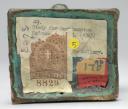 Henry Moore OM, CH, Maquette for Madonna and Child 1943, cast 1944-5© The Henry Moore Foundation. All Rights Reserved© The Henry Moore Foundation. All Rights Reserved
Henry Moore OM, CH, Maquette for Madonna and Child 1943, cast 1944-5© The Henry Moore Foundation. All Rights Reserved© The Henry Moore Foundation. All Rights Reserved -
 Henry Moore OM, CH, Maquette for Madonna and Child 1943, cast 1944-5© The Henry Moore Foundation. All Rights Reserved© The Henry Moore Foundation. All Rights Reserved
Henry Moore OM, CH, Maquette for Madonna and Child 1943, cast 1944-5© The Henry Moore Foundation. All Rights Reserved© The Henry Moore Foundation. All Rights Reserved -
 Henry Moore OM, CH, Maquette for Madonna and Child 1943, cast 1944-5© The Henry Moore Foundation. All Rights Reserved© The Henry Moore Foundation. All Rights Reserved
Henry Moore OM, CH, Maquette for Madonna and Child 1943, cast 1944-5© The Henry Moore Foundation. All Rights Reserved© The Henry Moore Foundation. All Rights Reserved -
 Henry Moore OM, CH, Maquette for Madonna and Child 1943, cast 1944-5© The Henry Moore Foundation. All Rights Reserved© The Henry Moore Foundation. All Rights Reserved
Henry Moore OM, CH, Maquette for Madonna and Child 1943, cast 1944-5© The Henry Moore Foundation. All Rights Reserved© The Henry Moore Foundation. All Rights Reserved
© The Henry Moore Foundation. All Rights Reserved
Henry Moore OM, CH,
Maquette for Madonna and Child
1943, cast 1944-5
© The Henry Moore Foundation. All Rights Reserved
This small bronze sculpture is one of twelve maquettes for a Madonna and Child that Henry Moore was commissioned to make in 1943 for St Matthew’s Church in Northampton. Although this particular design was not the one selected for St Matthew’s, an enlarged stone version was commissioned in 1945 for St Peter’s Church in Claydon, Suffolk, as a monument to four local men killed during the Second World War.
Henry Moore OM, CH 1898–1986
Maquette for Madonna and Child
1943, cast 1944–5
Bronze
185 x 90 x 75 mm
Inscribed ‘Moore’ on lower rear
Purchased from the artist through the Berkeley Galleries (Knapping Fund) 1945
In an edition of 7 plus 1 artist’s copy
N05603
Maquette for Madonna and Child
1943, cast 1944–5
Bronze
185 x 90 x 75 mm
Inscribed ‘Moore’ on lower rear
Purchased from the artist through the Berkeley Galleries (Knapping Fund) 1945
In an edition of 7 plus 1 artist’s copy
N05603
Ownership history
Purchased from the artist through the Berkeley Galleries (Knapping Fund) in 1945.
Exhibition history
1948
Sculpture and Drawings by Henry Moore, British Pavilion, Venice Biennale, Venice, June–September 1948, no.27d.
1971
Faith Alive, Northampton Central Museum and Art Gallery, Northampton, March–April 1971.
1972
Painting, Sculpture and Drawing in Britain 1940–49, Whitechapel Art Gallery, London, November 1972.
1978
The Henry Moore Gift, Tate Gallery, London, June–August 1978, no number.
1990–1
Henry Moore: Sketch-Models and Working-Models, Mead Gallery, University of Warwick Arts Centre, Coventry, May–June 1990; Huddersfield Art Gallery, Huddersfield, June–August 1990; Library Arts Centre, Wrexham, August–October 1990; Bristol Museum and Art Gallery, Bristol, October–November 1990; Towner Art Gallery, Eastbourne, December 1990–January 1991; Royal Albert Memorial Museum, Exeter, January–March 1991; Smith Art Gallery, Sterling, March–April 1991, no.5.
1998
Henry Moore and the National Gallery, National Gallery, London, April–May 1998.
1998
Special Exhibitions: Henry Moore, Imperial War Museum, London, September–November 1998.
2005
Henry Moore y México, Museo Dolores Olmedo, Mexico City, June–October 2005.
References
1944
Geoffrey Grigson and Eric Newton, ‘Henry Moore’s Madonna and Child’, Architectural Review, vol.95, no.569, May 1944, pp.137–40.
1944
Walter Hussey, ‘Correspondence [Letter to the Editor]’, Architectural Review, vol.96, no.570, July 1944, p.1.
1944
Herbert Read (ed.), Henry Moore: Sculpture and Drawings, London 1944, reproduced pl.107b.
1944
Kenneth Clark, ‘A Madonna by Henry Moore’, Magazine of Art, vol.37, no.7, November 1944, pp.247–9..
1945
Nikolaus Pevsner, ‘Thoughts on Henry Moore’, Burlington Magazine, vol.86, no.503, February 1945, pp.47–9.
1945
Philip Hendy, ‘Art – Henry Moore’, Britain Today, no.106, 1945, pp.34–5.
1946
James Johnson Sweeney, Henry Moore, exhibition catalogue, Museum of Modern Art, New York 1946, reproduced pl.74.
1946
Nikolaus Pevsner, ‘Henry Moore’s Madonna’, Student Movement, October 1946, pp.4–5.
1946
Mary Sorrell, ‘Henry Moore’, Apollo, vol.44, November 1946, pp.116–18.
1948
David Sylvester, ‘The Evolution of Henry Moore’s Sculpture II’, Burlington Magazine, vol.90, no.544, July 1948, pp.186, 189–95 (another cast reproduced p.191, pl.2).
1949
Walter Hussey, ‘A Churchman Discusses Art in the Church’, Studio, vol.138, no.678, September 1949, pp.80–1, 95.
1954
Lawrence Alloway, ‘The Siting of Sculpture’, Listener, 17 June 1954, pp.1044–6.
1957
David Sylvester (ed.), Henry Moore. Volume 1: Sculpture and Drawings 1921–1948, London 1957, p.13, no.222 (terracotta reproduced p.138).
1959
Erich Neumann, The Archetypal World of Henry Moore, London 1959 (terracotta reproduced pl.57).
1960
Will Grohmann, The Art of Henry Moore, London 1960, pp.137–9.
1965
Herbert Read, Henry Moore: A Study of his Life and Work, London 1965, pp.151–7.
1966
Donald Hall, Henry Moore: The Life and Work of a Great Sculptor, London 1966, pp.101–17.
1967
Henry Moore: One Yorkshireman Looks at his World, dir. by John Read, television programme, broadcast BBC2, 11 November 1967, http://www.bbc.co.uk/archive/henrymoore/8807.shtml, accessed 7 February 2014.
1968
John Russell, Henry Moore, London 1968, pp.90–9.
1968
John Hedgecoe (ed.), Henry Moore, London 1968, pp.157–65.
1973
John Russell, Henry Moore, 1968, revised edn, London 1973, pp.119–23.
1975
Kenneth Clark, ‘Dean Walter Hussey: A Tribute to his Patronage of the Arts’, Chichester Nine Hundred, Chichester 1975, pp.68–72.
1978
The Henry Moore Gift, exhibition catalogue, Tate Gallery, London 1978, reproduced p.23.
1979
John Read, Portrait of an Artist: Henry Moore, London 1979, p.105.
1981
Sandy Nairne and Nicholas Serota (eds.), British Sculpture in the Twentieth Century, exhibition catalogue, Whitechapel Art Gallery, London 1981, p.146.
1985
Walter Hussey, Patron of Art: The Revival of a Great Tradition Among Modern Artists, London 1985, pp.23–48.
1988
Susan Compton (ed.), Henry Moore, exhibition catalogue, Royal Academy of Arts, London 1988, pp.222–3.
1990
Henry Moore: Sketch-Models and Working-Models, exhibition catalogue, South Bank Centre, London 1990, no.5.
1992
Garth Turner, ‘Aesthete, Impresario and Indomitable Persuader: Walter Hussey at St Matthew’s, Northampton, and Chichester Cathedral’, in Diana Wood (ed.), The Church and the Arts, Oxford 1992, pp.523–35.
1992
Julian Stallabrass, ‘Henry Moore: Mother and Child’, in Henry Moore: Mutter und Kind / Mother and Child, exhibition catalogue, Käthe Kollwitz Museum, Cologne 1992, http://www.courtauld.ac.uk/people/stallabrass_julian/PDF/Moore.pdf, accessed 13 December 2013.
1993
Images of Christ: Religious Iconography in Twentieth Century British Art, exhibition catalogue, Northampton Museum and Art Gallery, Northampton 1993.
2003
Roger Berthoud, The Life of Henry Moore, 1987, revised edn, London 2003, pp.212–19.
2005
Henry Moore y México, exhibition catalogue, Museo Dolores Olmedo, Mexico City 2005.
2006
David Mitchinson (ed.), Celebrating Moore: Works from the Collection of the Henry Moore Foundation, London 2006, pp.207–9 (another cast reproduced p.208).
Technique and condition
This maquette of a seated woman holding a child in her lap is a solid bronze cast with no hollow cavity. The original model for this sculpture was made in clay and would have been used to make a mould from which the final bronze version could be cast. Moore made small impressions into the clay model to denote facial features and drapery, which are replicated in the bronze sculpture. The level of surface detail on the bronze suggests that it was made using the traditional lost wax casting technique. Although it is possible to see where casting flashes have been filed away and chased to blend with the surrounding surface, there is otherwise little post-cast finishing.
The bronze surface has been coloured using chemical patination techniques. First, a slightly transparent brown colour was applied over the surface, followed by a more opaque green colour, which was then rubbed back on high points using a light abrasive to pick out the details of the form (fig.1). The patina was then finished with a coating of wax. The brown base colour is often used on bronzes and is likely to have been applied using a solution of potassium polysulphide (otherwise known as ‘liver of sulphur’) in water. There are many different patina recipes used to produce green colours on bronzes but they often contain mixtures of copper and ammonium salts. Areas of unpatinated, pink-coloured bronze can be seen between the woman’s feet and on her chest.
The signature ‘MOORE’ is inscribed at the back of the bench towards the bottom using a sharp point, possibly into the clay model or the pre-cast wax. The sculpture is in generally good condition and has not required treatment.
Lyndsey Morgan
March 2011
How to cite
Lyndsey Morgan, 'Technique and Condition', March 2011, in Robert Sutton, ‘Maquette for Madonna and Child 1943, cast 1944–5 by Henry Moore OM, CH’, catalogue entry, December 2012, revised by Alice Correia, March 2014, in Henry Moore: Sculptural Process and Public Identity, Tate Research Publication, 2015, https://wwwEntry
Maquette for Madonna and Child is a small bronze sculpture cast from a study originally modelled in clay. It depicts a woman seated on a low bench holding a small child in her lap. She is dressed in a long-sleeved robe and sits with her knees apart. The child sits with its back to the woman’s chest and is supported by her arms and hands, which are placed together in her lap in front of the child. The knees of the child are raised and it has its right hand resting on the woman’s right arm.
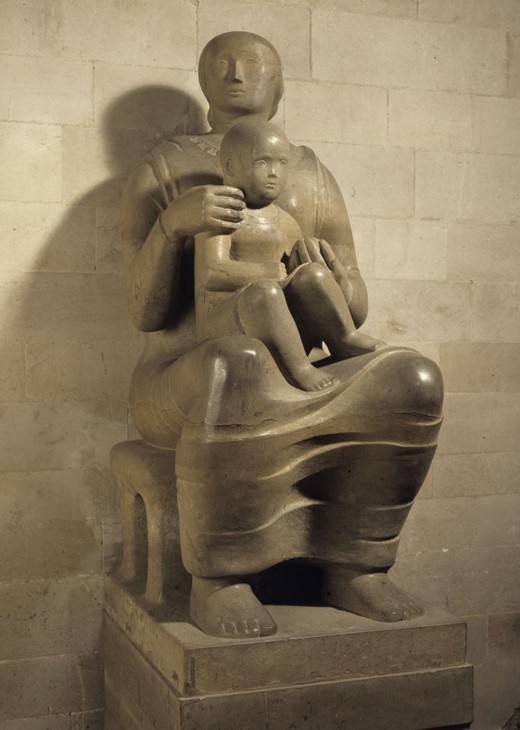
Henry Moore
Madonna and Child 1943–4
Hornton Stone
Church of St Matthew, Northampton
© The Henry Moore Foundation. All Rights Reserved
Photo: Henry Moore Foundation Archive
Fig.1
Henry Moore
Madonna and Child 1943–4
Church of St Matthew, Northampton
© The Henry Moore Foundation. All Rights Reserved
Photo: Henry Moore Foundation Archive
The commission
The commission came about after the vicar of St Matthew’s, the Reverend Walter Hussey, saw a number of Moore’s Shelter Drawings in an exhibition at the National Gallery, London, in the autumn of 1942. The exhibition had been organised by the War Artists’ Advisory Committee (WAAC), a governmental body set up under the auspices of the Ministry of Information to boost British morale during wartime by commissioning images of British endurance from recognised artists. In 1940, having been forced to give up sculpture due to a lack of available materials, Moore produced a series of drawings of women and children sheltering in the London Underground during the Blitz, which he showed to Kenneth Clark, Director of the National Gallery and hairman of the WAAC, who invited him to become an Official War Artist.
Although some visitors to the National Gallery found that Moore’s Shelter Drawings did not accurately convey the reality of their wartime experiences, on his return to Northampton, Hussey signalled his admiration for the work to Harold Williamson, Director of the Chelsea School of Art, which had been relocated to Northampton in 1941 to escape the bombing in London.1 As Hussey recalled in his memoirs, ‘I remember shaking my finger at him and saying: “That is the sort of man who ought to be working for the Church – his work has the dignity and force that is desperately needed today”’.2 Moore had taught sculpture at the Chelsea School of Art since 1933 and so was well known to Williamson, who arranged for the two to meet the following week when Moore was visiting Northampton. It was then that Hussey proposed the commission to Moore: ‘I asked him whether he thought he would be interested in the project; he replied that he would, though whether it could go further, whether he could and would want to do it, he just couldn’t say at present’. Hussey also asked Moore if he felt able to believe in the commission, to which the artist responded ‘Yes, I would. Though whether or not I should agree with your theology, I just do not know. I think it is only through our art that we artists can come to understand your theology’.3 Moore’s attitude to Christianity was ambivalent; he stated in 1973 that ‘although I was baptised and made to go to church as a boy, I am not a practicing Christian’.4
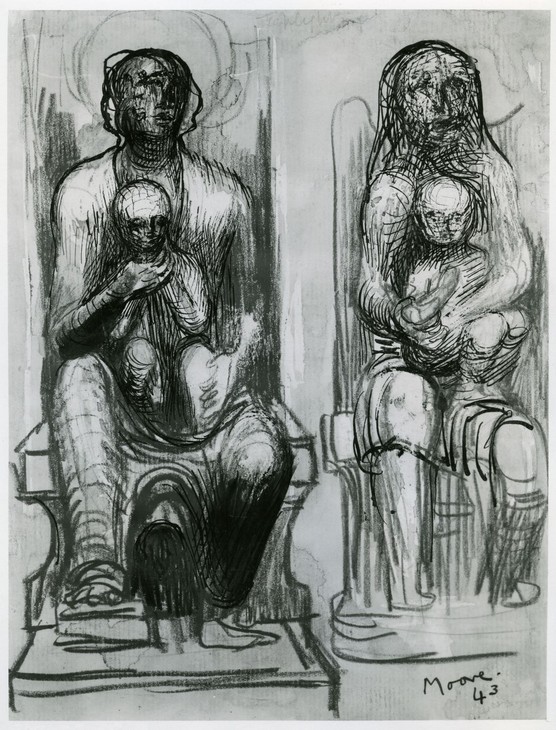
Henry Moore
Madonna and Child Studies 1943
Graphite, wax crayon, coloured crayon, watercolour wash, gouache, pen and ink on paper
225 x 175 mm
Private collection
© The Henry Moore Foundation. All Rights Reserved
Fig.2
Henry Moore
Madonna and Child Studies 1943
Private collection
© The Henry Moore Foundation. All Rights Reserved
Between April and June 1943 Moore created what is now identified as the Madonna and Child Sketchbook, and it is from these sketches that he modelled twelve clay maquettes between June and July. Each of the three-dimensional maquettes appear to have been drawn to varying extents.8 Among the sketches Moore produced at this time, the closest immediate precedent for this Maquette for Madonna and Child can be found on a single sheet, on which two similar representations of the subject were drawn (fig.2). On the left of the page the Madonna is depicted seated on a bench with her right foot resting on a raised step. Her right elbow rests on her raised right knee as her forearm crosses in front of the child seated in her lap. The child also sits with raised knees, but while both figures face the front, they look in different directions. The sketch on the right of the page presents the seated figures in similar poses. However, in this drawing, which is less finished than its counterpart, both the woman’s arms wrap around the child’s waist, while the child sits on the woman’s right thigh with its feet resting on her left thigh and its head and torso twisted to face forward. Tate’s Maquette for Madonna and Child features characteristics from both drawings, suggesting that the sculpture is a composite of the two.
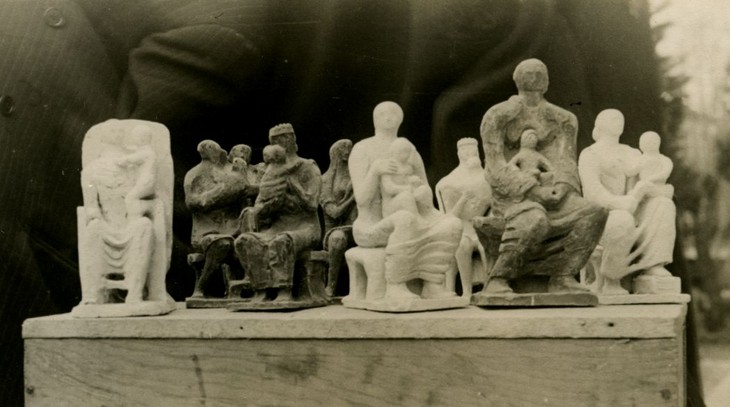
Photograph of six terracotta maquettes for Madonna and Child 1943
© The Henry Moore Foundation. All Rights Reserved
Photo: Henry Moore
Fig.3
Photograph of six terracotta maquettes for Madonna and Child 1943
© The Henry Moore Foundation. All Rights Reserved
Photo: Henry Moore
I was able to begin 4 or 5 days ago, translating some of the small note-book drawings I’d made, into small clay models and I’ve now got 4 clay models (each about 4” high) on the go. I don’t know yet what I think of these, and shan’t until each one has had a few more hours spent on it. But anyhow there are 4 or 5 small drawings in the note-book which I want to try out in solid forms in clay too, so it’s going to be another 2 or 3 weeks, I’m afraid.11
When seen together, the maquettes reveal how Moore experimented with the position and size of the Christ child and the pose of the Madonna, and testify to Moore’s growing interest in drapery. Moore later acknowledged that the folds of the mother’s dress in the maquettes were directly informed by his Shelter Drawings: ‘I had never used drapery in sculpture prior to making the shelter drawings. Then I saw sculptural form in the folds of the material and employed it’.12 The fact that Moore knew where the final sculpture was to be positioned in St Matthew’s Church also informed how he modelled the figures. The allocated site was against a wall, and as such Moore paid little attention to the backs of his maquettes. In his discussion of the commission, the art critic Herbert Read noted that the final sculpture had to confirm to what he called ‘the law of frontality’, by which Moore had to convey mass and volume without ‘an all round perambulation’.13
Of the twelve maquettes produced in clay five were selected by Moore to show to Hussey on 23 July 1943. This maquette was one of the five selected, and although it was not Moore’s preferred design for the final sculpture, he informed Hussey that he would ‘be prepared to base the finished statue’ on any one of the five.14 The production of multiple models provided Hussey not only with an element of choice but also a clearer idea of what the finished work might look like. After viewing the five proposed maquettes in London, Hussey took them back to Northampton to show members of St Matthew’s Parochial Church Council, who selected the sculpture to be commissioned. This Maquette for Madonna and Child was not chosen as the design for the final sculpture, which Moore carved throughout the latter half of 1943 and early 1944, and which was dedicated in St Matthew’s Church on Saturday 19 February 1944.
From clay to bronze
In Moore’s catalogue raisonné the clay studies for Madonna and Child are described as being made in terracotta.15 In 1963 Moore addressed any misunderstanding, explaining that ‘the original maquettes of the MADONNA AND CHILD ... sculptures were all modelled direct in clay and then baked, and so became terra-cottas. It was from these terra-cottas that the small bronzes were cast’.16 Moore’s catalogue raisonné also indicates that six of Moore’s preliminary terracotta maquettes were cast in bronze editions. This Maquette for Madonna and Child was cast at the Art Bronze Foundry in London. Notes made by Moore for the owner of the foundry, dated ‘March 28’, identify five Madonna and Child maquettes for casting, along with three maquettes for Moore’s Family Group, which date from 1944–5.17 The inclusion of Maquette for Family Group 1945 (Tate N05606) as the seventh sculpture on this list suggests that Moore made these casting notes in 1945. This Maquette for Madonna and Child is numbered three on the list, and a small sketch of the sculpture is annotated with the phrase ‘big Madonna + small child | bronze pattern’. The notes indicate that five bronze examples of this particular maquette were wanted, and that two had been cast by 28 March.
In an article published in the Burlington Magazine in July 1948, Sylvester, who had worked as Moore’s personal assistant in 1945, noted that ‘Moore had always made maquettes for his larger sculptures, but it was not until he cast about half-a-dozen of the ten or so clay studies for the Northampton Madonna that he began to make bronzes of them’.18 The bronzes were produced to be sold privately, and probably helped off-set the cost of the commission. Moore’s turn to making multiple bronze casts drastically altered the type of work he was able to produce, and provided more opportunities to sell his work.
Sources and development
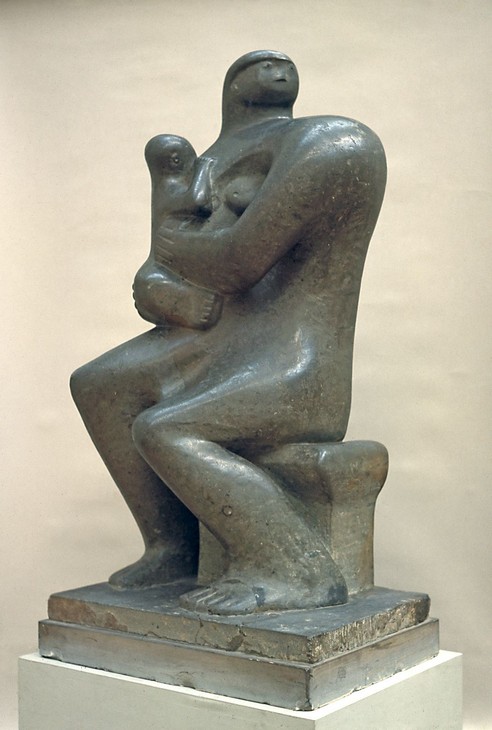
Henry Moore
Mother and Child 1932
Green Hornton stone
Sainsbury Centre for Visual Art, Norwich
© The Henry Moore Foundation. All Rights Reserved
Fig.4
Henry Moore
Mother and Child 1932
Sainsbury Centre for Visual Art, Norwich
© The Henry Moore Foundation. All Rights Reserved
I began thinking of the ‘Madonna and Child’ for St Matthew’s by considering in what ways a Madonna and Child differs from a carving of just a ‘Mother and Child’ – that is by considering how in my opinion religious art differs from secular art. It’s not easy to describe in words what this difference is, except by saying in general terms that the ‘Madonna and Child’ should have an austerity and a nobility and some touch of grandeur (even hieratic aloofness), which is missing in the ‘everyday’ Mother and Child idea.20
To create his Mother and Child sculpture in 1932 Moore had used the technique of direct carving, which involved working directly on the stone without reference to a model or preparatory sketches. In the early 1930s Moore and other contemporary sculptors, including Barbara Hepworth and John Skeaping, believed that by working directly on the stone, and in response to its particular physical properties, a sculptor could create a work of art that had more authenticity than one that eschewed the true qualities of its material. Moore later recalled that he ‘liked the different mental approach involved’ in direct carving, ‘that you begin with the block and have to find the sculpture that’s inside it’.21 By making small clay maquettes of the Madonna and Child prior to making the full-size stone carving, Moore therefore departed from this pre-war working method.
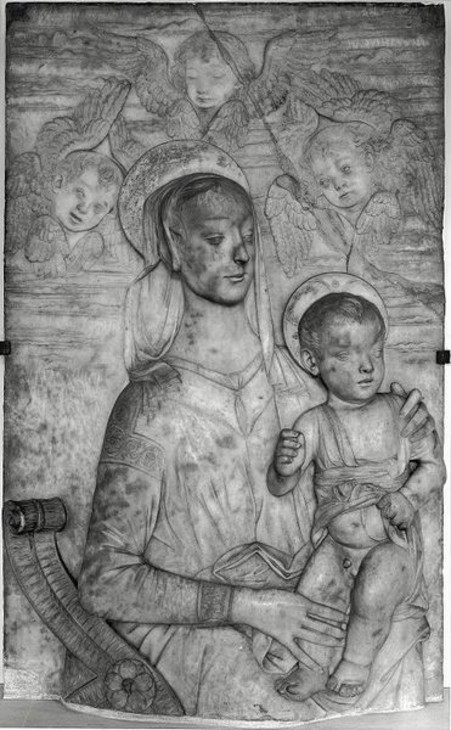
Domenico Rosselli
Virgin and Child 1450–98
Marble and gilt
1040 x 6550 x 1450 mm
Victoria and Albert Museum, London
Fig.5
Domenico Rosselli
Virgin and Child 1450–98
Victoria and Albert Museum, London
Six months’ exposure to the masterworks of European art which I saw on my trip had stirred up a violent conflict with my previous ideals. I couldn’t seem to shake off the new impressions, or make use of them without denying all I had devoutly believed in before. I found myself helpless and unable to work ... Still the effects of that trip never really faded. But until my Shelter Drawings during the war I never seemed to feel free to use what I learned on that trip to Italy in my art – to mix the Mediterranean approach comfortably with my interest in the more elementary concept of archaic and primitive peoples.24
By depicting drapery and evoking the postures and poses of historical examples of the Madonna and Child, Moore found that it was possible to draw upon the idealised representations of Renaissance art without compromising his own ‘elementary’ figurative style. In 2003 the art historian Margaret Garlake proposed that Moore’s turn to figuration with the Shelter Drawings and the Northampton commission ‘encouraged him to acknowledge that a more easily read figurative art was capable of being both radical and popular’.25
Moore and the Tate collection
This maquette was one of four bronze studies for the Northampton Madonna and Child bought by Tate in 1945 and was thus one of the earliest works by Moore to be purchased for the Tate collection. The purchase of these works illustrated the desire of the director Sir John Rothenstein to represent Moore’s work in the collection. In contrast, Rothenstein’s predecessor, J.B. Manson, had previously told the Tate trustee Robert Sainsbury ‘over my dead body will Henry Moore ever enter the Tate’.26 Rothenstein’s appointment thus signalled a shift in the direction of Tate’s ambitions. One of his first actions as director had been to accept the donation from the Contemporary Art Society of Moore’s Recumbent Figure 1938 (Tate N05387). Then in 1941 Rothenstein encouraged the appointment of Moore to Tate’s Board of Trustees.
In 1944 Rothenstein wrote to Moore asking whether Tate could commission another full-size Madonna and Child based on the existing maquettes. Moore politely turned down the suggestion, writing ‘its now more than a year since these little figure studies were done, + that’s whats [sic] making me hesitate now over your suggestion – for it would mean putting my mind back in working to a year ago’.27 Instead, Moore suggested that the Tate might be interested in some of the studies for a ‘Family Group’ he had recently begun working on. This proposal was accepted and Tate bought four maquettes for the Madonna and Child and three maquettes for the Family Group. Three of the Madonna and Child maquettes were bought at the relatively affordable price of twenty-five guineas each, while the maquette from which the final full-size version had been scaled up (Tate N05602) cost thirty guineas.28
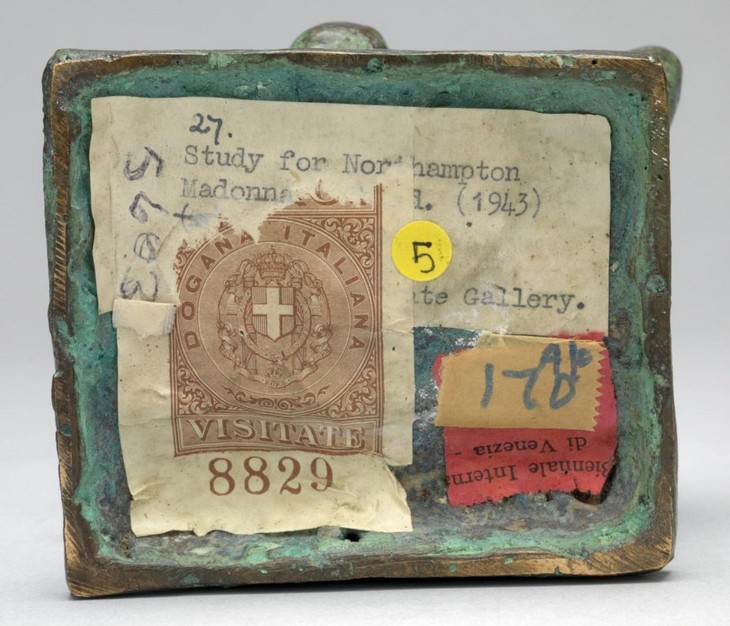
Detail of underside of Maquette for Madonna and Child 1943, cast 1944–5
Tate N05603
© The Henry Moore Foundation. All Rights Reserved
Fig.6
Detail of underside of Maquette for Madonna and Child 1943, cast 1944–5
Tate N05603
© The Henry Moore Foundation. All Rights Reserved
This Maquette for Madonna and Child was cast in an edition of seven plus one artist’s copy. Another example of this sculpture is held in the collection of the Henry Moore Foundation, while others are believed to be in private collections. Tate’s Madonna and Child maquettes were exhibited in Moore’s solo exhibition at the British Pavilion during the 1948 Venice Biennale, and the exhibition label can still be seen on the underside of this sculpture (fig.6).
Claydon Madonna and Child 1948–9
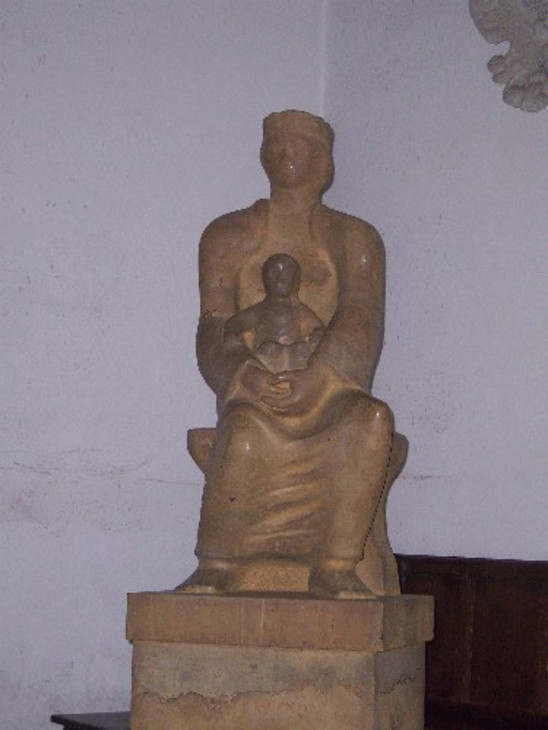
Henry Moore
Claydon Madonna and Child 1948–9
Brown Hornton stone
Church of St Mary and St Peter, Barham
© The Henry Moore Foundation. All Rights Reserved
Fig.7
Henry Moore
Claydon Madonna and Child 1948–9
Church of St Mary and St Peter, Barham
© The Henry Moore Foundation. All Rights Reserved
Robert Sutton
December 2012
Revised by Alice Correia
March 2014
Notes
Walter Hussey, Patron of Art: The Revival of a Great Tradition Among Modern Artists, London 1985, p.23.
Henry Moore cited in Donald Carroll, The Donald Carroll Interviews, London 1973, p.35, reprinted in Alan Wilkinson (ed.), Henry Moore: Writings and Conversations, Aldershot 2002, p.269.
The pages from the sketchbook are reproduced in Ann Garrould (ed.), Henry Moore. Volume 3: Complete Drawings 1940–49, Aldershot 2001, pp.190–5.
Moore photographed these terracotta maquettes in various groupings prior to their casting. Fig.3 illustrates six of the twelve models and were reproduced in Herbert Read (ed.), Henry Moore: Sculptures and Drawings, London 1944. This book would become the basis for the first volume of Moore’s catalogue raisonné, in which the same two photographs have been reproduced ever since. See David Sylvester (ed.), Henry Moore. Volume 1: Complete Sculpture 1921–48, 1957, 5th edn, London 1988, p.138.
A.D.B. Sylvester, ‘The Evolution of Henry Moore’s Sculpture: I’, Burlington Magazine, vol.90, no.543, June 1948, p.158.
Henry Moore, letter to Martin Butlin, 22 January 1963, Tate Artist Catalogue File, Henry Moore, A23941.
See Ann Garrould (ed.), Henry Moore. Volume 3: Complete Drawings 1940–49, Much Hadham 2001, p.195, no.43.105.
David Sylvester, ‘The Evolution of Henry Moore’s Sculpture: II’, Burlington Magazine, vol.90, no.544, July 1948, p.190.
See John and Véra Russell, ‘Conversations with Henry Moore’, Sunday Times, 17 December 1961, reprinted in Wilkinson 2002, pp.47, 230.
Henry Moore, Head of the Virgin 1922–3 (The Henry Moore Foundation), http://catalogue.henry-moore.org:8080/emuseum/view/objects/asitem/search@/3/invno-asc?t:state:flow=fad5a4f3-134d-4bdf-972c-34b2a62810c0 , accessed 6 March 2014.
Henry Moore cited in James Johnson Sweeny, ‘Henry Moore’, Partisan Review, March–April 1947, p.183, reprinted in Wilkinson 2002, p.54.
Margaret Garlake, ‘Moore’s Eclecticism: Difference, Aesthetic Identity and Community in the Architectural Commissions 1938–1958’, in Jane Beckett and Fiona Russell (eds.), Henry Moore: Critical Essays, Aldershot 2003, p.174.
Roger Berthoud, The Life of Henry Moore, 1987, revised edn, London 2003, p.183. Manson’s remark was cited by Sainsbury during an interview undertaken by Berthoud in May 1983.
For further information about the location and condition of the ‘Claydon’ Madonna and Child see http://racns.co.uk/sculptures.asp?action=getsurvey&id=956 , accessed 6 March 2014.
Related essays
- Myriad Mediations: Henry Moore and his Works on Screen 1937–83 John Wyver
- Fashioning a Post-War Reputation: Henry Moore as a Civic Sculptor c.1943–58 Andrew Stephenson
- At the Heart of the Establishment: Henry Moore as Trustee Julia Kelly
- Henry Moore's Approach to Bronze Lyndsey Morgan and Rozemarijn van der Molen
- ‘Worthy of the great tradition’: Kenneth Clark on Henry Moore Chris Stephens
Related catalogue entries
Related material
-
Programme for the unveiling and dedication of the statue ... 19 February 1944Programme
Related reviews and articles
- Philip Hendy, ‘Henry Moore: his New Exhibition’ Britain Today, no.158, June 1949.
Related bibliography
How to cite
Robert Sutton, ‘Maquette for Madonna and Child 1943, cast 1944–5 by Henry Moore OM, CH’, catalogue entry, December 2012, revised by Alice Correia, March 2014, in Henry Moore: Sculptural Process and Public Identity, Tate Research Publication, 2015, https://www

